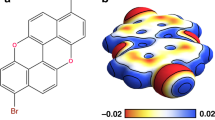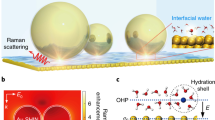Abstract
Water/solid interfaces are vital to our daily lives and are also a central theme across an incredibly wide range of scientific disciplines. Resolving the internal structure, that is, the O–H directionality, of water molecules adsorbed on solid surfaces has been one of the key issues of water science yet it remains challenging. Using a low-temperature scanning tunnelling microscope, we report submolecular-resolution imaging of individual water monomers and tetramers on NaCl(001) films supported by a Au(111) substrate at 5 K. The frontier molecular orbitals of adsorbed water were directly visualized, which allowed discrimination of the orientation of the monomers and the hydrogen-bond directionality of the tetramers in real space. Comparison with ab initio density functional theory calculations reveals that the ability to access the orbital structures of water stems from the electronic decoupling effect provided by the NaCl films and the precisely tunable tip–water coupling.
This is a preview of subscription content, access via your institution
Access options
Subscribe to this journal
Receive 12 print issues and online access
$259.00 per year
only $21.58 per issue
Buy this article
- Purchase on Springer Link
- Instant access to full article PDF
Prices may be subject to local taxes which are calculated during checkout




Similar content being viewed by others
Change history
21 December 2016
In the version of this Article originally published, the title of ref. 1 was incorrect and should have read: 'The interaction of water with solid surfaces: fundamental aspects revisited'. This was corrected on 21 December 2016.
References
Henderson, M. A. The interaction of water with solid surfaces: fundamental aspects revisited. Surf. Sci. Rep. 46, 1–308 (2002).
Hodgson, A. & Haq, S. Water adsorption and the wetting of metal surfaces. Surf. Sci. Rep. 64, 381–451 (2009).
Feibelman, P. J. Partial dissociation of water on Ru(0001). Science 295, 99–102 (2002).
Meng, S., Xu, L. F., Wang, E. G. & Gao, S. Vibrational recognition of hydrogen-bonded water networks on a metal surface. Phys. Rev. Lett. 89, 176104 (2002).
Carrasco, J., Hodgson, A. & Michaelides, A. A molecular perspective of water at metal interfaces. Nature Mater. 11, 667–674 (2012).
Nagasaka, M., Kondoh, H., Amemiya, K., Ohta, T. & Iwasawa, Y. Proton transfer in a two-dimensional hydrogen-bonding network: Water and hydroxyl on a Pt(111) surface. Phys. Rev. Lett. 100, 106101 (2008).
Kumagai, T., Okuyama, H., Hatta, S., Aruga, T. & Hamada, I. H-atom relay reactions in real space. Nature Mater. 11, 167–172 (2012).
Shen, Y. R. & Ostroverkhov, V. Sum-frequency vibrational spectroscopy on water interfaces: Polar orientation of water molecules at interfaces. Chem. Rev. 106, 1140–1154 (2006).
Kimmel, G. A. et al. Polarization- and azimuth-resolved infrared spectroscopy of water on TiO2(110): Anisotropy and the hydrogen-bonding network. J. Phys. Chem. Lett. 3, 778–784 (2012).
Repp, J., Meyer, G., Stojković, S. M., Gourdon, A. & Joachim, C. Molecules on insulating films: Scanning-tunneling microscopy imaging of individual molecular orbitals. Phys. Rev. Lett. 94, 026803 (2005).
Mitsui, T., Rose, M. K., Fomin, E., Ogletree, D. F. & Salmeron, M. Water diffusion and clustering on Pd(111). Science 297, 1850–1852 (2002).
Morgenstern, K. & Nieminen, J. Intermolecular bond length of ice on Ag(111). Phys. Rev. Lett. 88, 066102 (2002).
Cerdá, J. et al. Novel water overlayer growth on Pd(111) characterized with scanning tunneling microscopy and density functional theory. Phys. Rev. Lett. 93, 116101 (2004).
Verdaguer, A., Sacha, G. M., Bluhm, H. & Salmeron, M. Molecular structure of water at interfaces: Wetting at the nanometer scale. Chem. Rev. 106, 1478–1510 (2006).
Michaelides, A. & Morgenstern, K. Ice nanoclusters at hydrophobic metal surfaces. Nature Mater. 6, 597–601 (2007).
Carrasco, J. et al. A one-dimensional ice structure built from pentagons. Nature Mater. 8, 427–431 (2009).
He, Y., Tilocca, A., Dulub, O., Selloni, A. & Diebold, U. Local ordering and electronic signatures of submonolayer water on anatase TiO2(101). Nature Mater. 8, 585–589 (2009).
Shin, H-J. et al. State-selective dissociation of a single water molecule on an ultrathin MgO film. Nature Mater. 9, 442–447 (2010).
Hammer, B., Wendt, S. & Besenbacher, F. Water adsorption on TiO2 . Top. Catal. 53, 423–430 (2010).
Nie, S., Feibelman, P. J., Bartelt, N. C. & Thürmer, K. Pentagons and heptagons in the first water layer on Pt(111). Phys. Rev. Lett. 105, 026102 (2010).
Okuyama, H. & Hamada, I. Hydrogen-bond imaging and engineering with a scanning tunnelling microscope. J. Phys. D 44, 464004 (2011).
Allen, H. C., Laux, J. M., Vogt, R., Finlayson-Pitts, B. J. & Hemminger, J. C. Water-induced reorganization of ultrathin nitrate films on NaCl: Implications for the tropospheric chemistry of sea salt particles. J. Phys. Chem. 100, 6371 (1996).
Taylor, D. P., Hess, W. P. & McCarthy, M. I. Structure and energetics of the water/NaCl(100) interface. J. Phys. Chem. B 101, 7455–7463 (1997).
Liu, L. M., Laio, A. & Michaelides, A. Initial stages of salt crystal dissolution determined with ab initio molecular dynamics. Phys. Chem. Chem. Phys. 13, 13162–13166 (2011).
Lauwaet, K. et al. Resolving all atoms of an alkali halide via nanomodulation of the thin NaCl film surface using the Au(111) reconstruction. Phys. Rev. B 85, 245440 (2012).
Hebenstreit, W. et al. Atomic resolution by STM on ultra-thin films of alkali halides: Experiment and local density calculations. Surf. Sci. 424, L321–L328 (1999).
Cabrera-Sanfelix, P., Arnau, A., Darling, G. R. & Sanchez-Portal, D. Water adsorption and diffusion on NaCl(100). J. Phys. Chem. B 110, 24559–24564 (2006).
Yang, Y., Meng, S. & Wang, E. G. Water adsorption on a NaCl(001) surface: A density functional theory study. Phys. Rev. B 74, 245409 (2006).
Ho, W. Single-molecule chemistry. J. Chem. Phys. 117, 11033–11061 (2002).
Martı´nez, J. I., Abad, E., González, C., Flores, F. & Ortega, J. Improvement of scanning tunneling microscopy resolution with H-sensitized tips. Phys. Rev. Lett. 108, 246102 (2012).
Nørskov, J. K. Chemisorption on metal surfaces. Rep. Prog. Phys. 53, 1253–1295 (1990).
Perrin, M. L. et al. Large tunable image-charge effects in single-molecule junctions. Nature Nanotech. 8, 282–287 (2013).
Sautet, P. & Joachim, C. Calculation of the benzene on rhodium STM images. Chem. Phys. Lett. 185, 23–30 (1991).
Lawton, T. J., Carrasco, J., Baber, A. E., Michaelides, A. & Sykes, E. C. H. Visualization of hydrogen bonding and associated chirality in methanol hexamers. Phys. Rev. Lett. 107, 256101 (2011).
Horcas, I. et al. WSXM: A software for scanning probe microscopy and a tool for nanotechnology. Rev. Sci. Instrum. 78, 013705 (2007).
Klimeš, J., Bowler, D. R. & Michaelides, A. Van der Waals density functionals applied to solids. Phys. Rev. B 83, 195131 (2011).
Kresse, G. & Hafner, J. Ab initio molecular dynamics for liquid metals. Phys. Rev. B 47, 558–561 (1993).
Kresse, G. & Furthmüller, J. Efficient iterative schemes for ab initio total- energy calculations using a plane-wave basis set. Phys. Rev. B 54, 11169–11186 (1996).
Kresse, G. & Joubert, D. From ultrasoft pseudopotentials to the projector augmented-wave method. Phys. Rev. B 59, 1758–1775 (1999).
Jonsson, H. et al. Classical and Quantum Dynamics in Condensed Phase Simulations Ch. 8 (World Scientific, 1998).
Acknowledgements
This work was supported by the National Basic Research Programs of China under Grant No. 2012CB921303, the National Science Foundation of China under Grant Nos 11104004, 11290162, 11275008, 91321309 and 91021007, and the Research Fund for the Doctoral Program of Higher Education of China under Grant No. 20110001120126. We thank W. Ji, S. Meng, S. W. Gao and W. Ho for enlightening discussions.
Author information
Authors and Affiliations
Contributions
Y.J. and E.W. designed and supervised the project. J.G., X.M. and Y.J. performed the STM measurements. J.C., X-Z.L. and E.W. carried out the DFT calculations. J.G., X.M., J.C., J.P., X-Z.L., L.X., E.W. and Y.J. analysed the data. J.S. contributed to the STM programming. J-R.S. contributed to the interpretation of the data. Y.J. wrote the manuscript with J.G., X.M., J.C., J.P., X-Z.L. L.X. and E.W. The manuscript reflects the contributions of all authors.
Corresponding authors
Ethics declarations
Competing interests
The authors declare no competing financial interests.
Supplementary information
Supplementary Information
Supplementary Information (PDF 1218 kb)
Rights and permissions
About this article
Cite this article
Guo, J., Meng, X., Chen, J. et al. Real-space imaging of interfacial water with submolecular resolution. Nature Mater 13, 184–189 (2014). https://doi.org/10.1038/nmat3848
Received:
Accepted:
Published:
Issue Date:
DOI: https://doi.org/10.1038/nmat3848
This article is cited by
-
Identification of a common ice nucleus on hydrophilic and hydrophobic close-packed metal surfaces
Nature Communications (2023)
-
Ortho-para interconversion of nuclear states of H2O through replica transition state: prospect of quantum entanglement at homodromic Bjerrum defect site
Journal of Molecular Modeling (2023)
-
Cryo-SEM and confocal LSM studies of agar gel, nanoparticle hydrocolloid, mineral clays and saline solutions
Scientific Reports (2022)
-
Human- and machine-centred designs of molecules and materials for sustainability and decarbonization
Nature Reviews Materials (2022)



